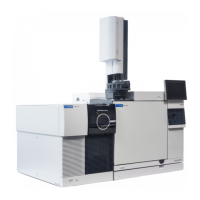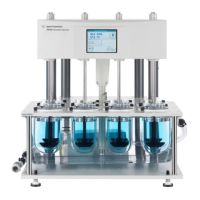2 Installing 8890 GC Columns
The GC/MS Interface for an 8890 Series GC
48 7000/7010 Series TQ GC/MS Operating Manual
When operating in CI mode, reagent gas is plumbed into the interface. The
interface assembly extends into the ionization chamber. A spring-loaded seal
helps to keep reagent gases inside the source. The reagent gas enters the
interface body and mixes with carrier gas and sample in the ion source.
The GC/MS interface is heated by an electric cartridge heater. Normally, the
heater is powered and controlled by the Thermal Aux #2 heated zone of the GC.
The interface temperature can be set from the Agilent MassHunter GC/MS
Acquisition software or from the GC. A sensor (thermocouple) in the interface
monitors the temperature.
The interface tip seal assembly is also required when using the EI XTR source or
the HES.
The interface should be operated in the 250 to 350 C range. Subject to that
restriction, the interface temperature should be slightly higher than the
maximum GC oven temperature, but never higher than the maximum column
temperature. When operating in CI mode, 280 C is the recommended
temperature for the GC/MS interface.
(See “To Install a Capillary Column in the GC/MS Interface Using the
Self-Tightening Column Nut” on page 37 and“To Install a Capillary Column in
the GC/MS Interface Using a Standard Column Nut” on page 42.)
Never exceed the maximum column temperature, either in the GC/MS
interface, the GC oven, or the inlet.
The GC/MS interface operates at high temperatures. If you touch it when it is
hot, it will burn you.

